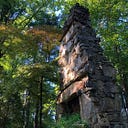Member-only story
The Ghosts of Harrow
When I was working on an essay that examines Frank Yerby’s The Foxes of Harrow (1946) and the 1947 film adaptation that appeared a year after its publication, I reread Foxes. During that reread, the opening two pages of the book stood out because of the way that Yerby uses them to frame the novel and to subvert the moonlight and magnolia myth of books such as Margaret Mitchell’s Gone With the Wind. These pages serve as a sort of preface; however, they are only labeled “The Foxes of Harrow.”
In the opening section of The Foxes of Harrow, Yerby addresses the reader directly and describes the present decaying state of the once magnificent house of Harrow. It is here, within these two pages, that Yerby sets up the protest that weaves its way underneath the surface of Stephen Fox’s rise to wealth and power, and eventual downfall, in Antebellum Louisiana. The overarching theme of Yerby’s career, a deconstruction of the myths that perpetuate the Old South, arise within the first words that many readers would encounter from Yerby.
